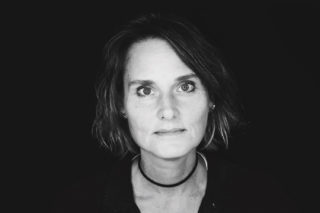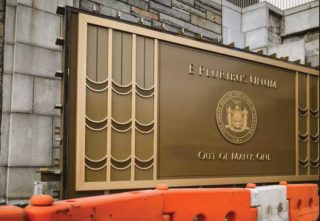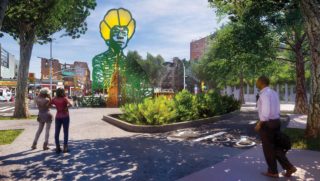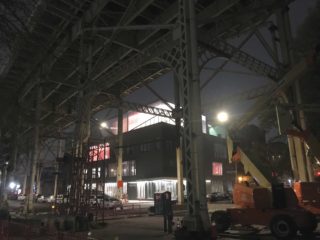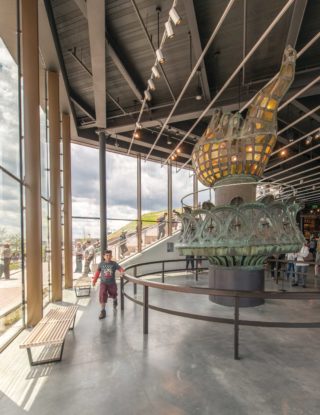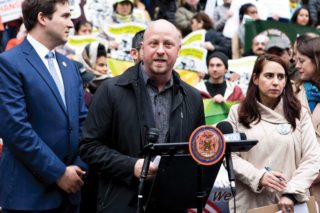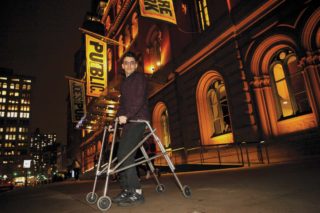Late last year, in response to a decline in apparel manufacturing, the City Council lifted zoning rules in the Garment District that required landlords on the area’s side streets to offset any newly created office space with an equal amount of manufacturing space—most of it for the rag trade. But with much of the manufacturing moving overseas, the work that remains tends to be on the high end of the spectrum. It complements fashion showrooms and design offices nearby, to say nothing of the WeWork branches, non-profits, and tech firms moving in. For Camille Tetard and Nicola Caito, the 1920s loft-style buildings were perfect for them to put to their original use.

Coming from a line of Italian tailors, the French-born Caito spent several years working for the French couturiers before moving to New York. Here, the couple saw a market for his precise craftsmanship. Soon he was working with Thakoon, Carolina Herrera, and Hervé Pierre. With Pierre, he helped craft Melania Trump’s inaugural gown (and also created gowns for Hillary Clinton and Michelle Obama).
The couple runs a multicultural firm with employees that have hailed from China, Korea, Japan, and Brazil. But the two said they hire based on humbleness, not culture. New York assertiveness, often encouraged by the big design schools, doesn’t fly here. “They come out of Parsons, where they don’t have a degree specifically in patternmaking, because it doesn’t exist, and they want $80,000 per year,” said Tetard.
Caito noted that the firm hired an “American apprentice—and she’s wonderful.” But the willingness to learn crosses international boundaries, particularly with couture-level craft. “The Italians and the French have hundreds of years of doing this kind of work, so it is a big part of the way we’re going to approach the world,” said Caito, adding that he can tell right away when someone is bluffing about their knowledge, usually because they’re aggressive.
“I look for that person who’s humble and not the bluffer,” he said. “You find these two kinds of people anywhere in the world: not only in New York, not only in Paris.”
Keep reading:
1. East Village, Manhattan: Ryan Haddad, Playwright and Performer at the Public Theater
2. SoHo, Manhattan: Charles Leslie, Founder of the Leslie-Lohman Museum of Gay and Lesbian Art, at the Museum
3. Arthur Avenue, the Bronx: Michael Rella and Peter Servedio, Butchers at Peter’s Meat Market, the Arthur Avenue Retail Market
> Garment District, Manhattan: Nicola Caito and Camille Tetard, Patternmakers, at their Atelier
5. Grand Concourse, the Bronx: Basma Sheea, Bengali-American Singer, at the Andrew Freeman Home
4. Garment District, Manhattan: Nicola Caito and Camille Tetard, Patternmakers, at their Atelier
6. Grand Concourse, the Bronx: Elissa Carmona, Lead Singer and Founder of the Marrisania Band Project, at the Bronx Museum of the Arts
7. Washington Heights, Manhattan: John Paul Enfante, Writer and Teacher, at the Hispanic Society
8. Midtown, Manhattan: Ness McKelvey at Home
9. St. George, Staten Island: Bain Coffman and Gui Junta, Restaurant Owners at Chang Noi Thai
10. Astoria, Queens: Admir Ekmestic, Former Soccer Player, at Mrki’s Place ONLINE EXCLUSIVE
11. Astoria, Queens: Dee Flattery, Pub Owner at The Quay ONLINE EXCLUSIVE
12. Tomkinsville, Staten Island: Veronica Arze, Café Owner at Duzer’s Local ONLINE EXCLUSIVE








